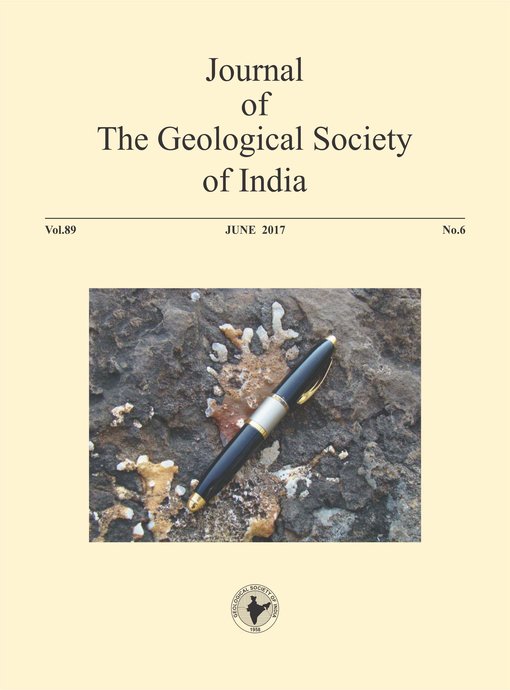Assessment of Carcinogenic and Non-Carcinogenic Risk from Exposure to Uranium in Groundwater from Western Haryana, India
DOI:
https://doi.org/10.1007/s12594-017-0675-yAbstract
This study was carried out to assess the distribution of uranium in groundwater by using LED fluorimeter LF-2a and chemical and radiological risks associated with its consumption in Sirsa district, Haryana, India. Uranium concentration ranged between 0.93 and 290μgl-1 with an average value of 49 μgl-1. About 44% of the groundwater samples had uranium concentration above the maximum contamination level of 30 μgl-1 prescribed by the World Health Organization and United States Environmental Protection Agency and 22% of the samples exceeded the permissible limit of 60 μgl-1 prescribed by the Atomic Energy Regulatory Board, India. The average cancer morbidity and mortality risks are determined to be 1.10 í— 10-4 and 7.17 í— 10-5 respectively, indicating the negligible carcinogenic risk. Hazard quotient for 44% samples is greater than unity which indicates health risk due to chemical toxicity of uranium in groundwater. The associated age-dependent annual effective dose is estimated by taking the prescribed water intake values of different age groups.Downloads
Metrics
Issue
Section
Downloads
Published
How to Cite
References
Atomic Energy Regulatory Board (2004) Directive for limit on uranium in drinking water, India, Mumbai: AERB.
Bajwa, B.S., Kumar, S., Singh, S., Sahoo, S.K. and Tripathi, R.M. (2015) Uranium and other heavy toxic elements distribution in the drinking water samples of SW-Punjab, India. Jour. Radiat. Res. Appl. Sci., doi:10.1016/ j.jrras.2015.01.002
BIS (Bureau of Indian Standards)(2012) Indian Standard, Drinking Water – Specification, Second Revision, New Delhi.
Bronzovic, M. and Marovic, G. (2005) Age-dependent dose assessment of 226Ra from bottled water intake. Health Phys.,v.88, pp.480-485.
Central Ground Water Board(2013) Ground water information booklet Sirsa district, Haryana. Ministry of Water Resources Government of India, North Western Region, Chandigarh. http://cgwb.gov.in/District_Profile/Haryana/Sirsa.Pdf
Chakrabarty, A., Mohapatra, S., Tripathi, R.M., Puranik, V.D. and Kushwaha, H.S. (2010) Quality control of uranium concentration measurements. Accred. Qual. Assur.,v.15, pp.119-123.
Duggal, V., Rani, A. and Balaram, V. (2016a) Assessment of age-dependent radiation dose due to intake of uranium and thorium in drinking water from Sikar district, Rajasthan, India. Radiat. Prot. Dosim., doi:10.1093/ rpd/ncw070.
Duggal, V., Rani, A., Mehra, R., Saini, K. and Bajwa, B.S. (2016b) Assessment of age-dependent radiation dose and toxicity risk due to intake of uranium through the ingestion of groundwater from Northern Rajasthan, India. Toxicol. Environ. Chem. http://dx.doi.org/10.1080/02772248.2016.11 96210
Garg, V.K., Yadav, A., Singh, K., Singh, M., Bishnoi, M. and Pulhani, V.(2014) Uranium concentration in groundwater in Hisar City, India. Int. Jour. Occup. Environ. Med.,v.5, pp.112-114.
International Atomic Energy Agency (2011) Radiation protection and safety of radiation sources: International Basic Safety Standards. Interim Edition, General Safety Requirements Part 3, No. GSR Part 3 (Interim), IAEA, Vienna.
Kansal, S., Mehra, R. and Singh, N.P. (2011) Uranium concentration in ground water samples belonging to some areas of Western Haryana, India using fission track registration technique. Jour. Public Health Epidem., v.3(8), pp.352-357.
Kumar, A., Tripathi, R.M., Rout, S., Mishra, M.K., Ravi, P.M. and Ghosh, A.K. (2014) Characterization of groundwater composition in Punjab state with special emphasis on uranium content, speciation and mobility. Radiochem. Acta, v.102, pp.239-254.
Patra, A.C., Mohapatra, S., Sahoo, S.K., Lenka, P., Dubey, J.S., Tripathi, R.M. and Puranik, V.D. (2013) Age-dependent dose and health risk due to intake of uranium in drinking water from Jaduguda, India. Radiat. Prot. Dosim., v.155, pp.210-216.
Rangel, J.I.D., delRio, H.L., Garcia, F.M., Torres, L.L.Q., Villalba, M.L., Sujo, L.C. and Cabrera, M.E.M. (2002) Radioactivity in bottled waters sold in Mexico. Appld. Radiat. Isot., v.56, pp.931-936.
Rani, A., Mehra, R. and Duggal, V. (2013a) Analysis of uranium concentration in drinking water samples using ICPMS. Health Phys., v.104, pp.251-255.
Rathore, D.P.S. (2013) Interpretation and evaluation of the variation in uranium, measure cations and anions; content of hydro geochemical samples with reference to the final interval between sampling and analysis. Explor. Res. Atomic Miner.,v.23, pp.207-215.
Rathore, D.P.S., Tarafder, P.K., Kayal, M. and Kumar, M. (2001) Application of a differential technique in laser-induced fluorimeter: simple and a precise methods for the direct determination of uranium in mineralized rocks at the percentage level. Analytica Chemica Acta,v.434, pp.201-208.
Sahoo, S.K., Mohapatra, S., Chakrabarty, A., Sumesh, C.G., Jha, V.N., Tripathi, R.M. and Puranik, V.D. (2009) Distribution of uranium in drinking water and associated age-dependent radiation dose in India. Radiat. Prot. Dosim., v.136, pp.108-113.
Sahoo, S.K., Mohapatra, S., Chakrabarty, A., Sumesh, C.G., Jha, V.N., Tripathi, R.M. andPuranik, V.D. (2010) Determination of uranium at ultra-trace level in packed drinking water by laser fluorimeter and consequent ingestion dose. Radio protection, v.45, pp.55-66.
Singh, B., Garg, V.K., Yadav, P., Kishore, N. andPulhani, V. (2014) Uranium in groundwater from Western Haryana, India. Jour. Radioanal. Nucl. Chem., v.301, pp.427-433.
Singh, B., Kataria, N., Garg, V.K., Yadav, P., Kishore, N. and Pulhani, V. (2015) Uranium quantification in groundwater and health risk from its ingestion in Haryana, India. Toxicol. Environ. Chem., doi:10.1080/ 02772248.2015.1025787
Singh, S., Rani, A., Mahajan, R.K. and Walia, T.P.S .(2003) Analysis of uranium and its correlation with some physico-chemical properties of drinking water samples from Amritsar, Punjab. Jour. Environ. Monitor., v.5, pp.917-921.
United States Environmental Protection Agency (1989) Risk assessment guidance for superfund human health evaluation manual. (Part A) EPA 540-1-89-002. Washington, DC.
United States Environmental Protection Agency (1991) Review of RSC analysis. Report prepared by Wade Miller Associates, Inc. for the US Environmental Protection Agency, Washington, DC.
United States Environmental Protection Agency (1999) Cancer risk coefficients for environmental exposure to radionuclides. Federal Guidance Report No. 13. EPA 402-R-99-001. Washington, DC.
United States Environmental Protection Agency (2011) Edition of the drinking water standards and health advisories. EPA 820-R-11-002, Office of Water, USEPA, DC.
US National Academy of Science, Institute of Medicine, Food and Nutrition Board (2004) Dietary reference intakes for water, potassium, sodium, chloride and sulphate. Washington, DC: The National Academies Press.
WHO (World Health Organization) (1984) Guidelines for Drinking Water Quality. Is ted. Geneva.
WHO (World Health Organization) (2004) Guidelines for Drinking Water Quality. 3rd ed. Geneva.
WHO (World Health Organization) (2011) Guidelines for drinking-water quality. 4th ed. Geneva.

 Vikas Duggal
Vikas Duggal






